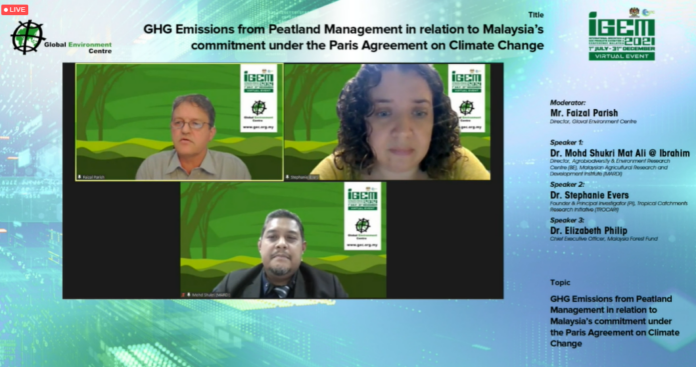Petaling Jaya, 30 September 2021 – Peatlands are the largest natural carbon store in Malaysia, but increasing clearance, drainage and fires are leading to massive emissions. Unless Malaysia rapidly changes its approach and better protects and restores peatlands, it will be hard to meet the country’s target for carbon neutrality by 2050 as announced by the Prime Minister in Parliament on 27 September.
Malaysia’s 2.56 million hectares (ha) of tropical peatlands form a critical buffer against flooding during the wet season and insurance against drought in the dry season as well as being critical habitat for diverse and endangered flora and fauna. Peatlands are an important ecosystem for carbon storage to regulate the global climate. However, damaged peatlands release greenhouse gas (GHG) into the atmosphere contributing to global climate change.
Tropical Catchment and Research Initiative (TROCARI)1 Founder and Principal Investigator, Dr Stephanie Evers, pointed out that peatlands are one of the most important ecosystems for carbon storage but these carbon stores are affected by drainage and fires, releasing significant amounts of GHG in Malaysia. Recent work has indicated that drained peatlands can release 40 to 100 tonnes of carbon dioxide per ha annually much higher than the figures used earlier for estimating and reporting GHG emissions in Malaysia.
Drainage, peatland conversion lead to 40-100 mt of CO2 emissions annually
With more than a million ha of peatlands developed for agriculture and oil palm, the annual emissions from drained peatlands is between 40 to 100 million tonnes of carbon dioxide, is equivalent to 17-38% of the total GHG emissions by Malaysia in 2019. Unless these emissions are properly controlled or reduced, Malaysia will not meet its ambitious emission reduction targets.
Dr Evers said this during the Virtual International Greentech & Eco Products Exhibition & Conference Malaysia (IGEM) 2021 Conference Session today. The Conference Session on entitled GHG Emissions from Peatland Management in relation to Malaysia’s Commitment under the Paris Agreement on Climate Change was organised by Global Environment Centre (GEC) and the Malaysian Green Technology Corporation (MGTC).
Fellow panelist, Dr Mohd Shukri Mat Ali @Ibrahim, Director of the Agrobiodiversity and Environment Research Centre (BE) of the Malaysian Agricultural Research and Development Institute (MARDI) highlighted that MARDI’s research in Saratok, Sarawak identified peat fires as another major problem and source of CO2 emissions. This, is one of the five sources of carbon loss under agro-ecosystems in Malaysia. The other primary sources/drivers are land use change, drainage, crop type and temperature.
Dr Shukri acknowledged that in the past, information on CO2 emissions in agricultural peatlands in Malaysia was grossly lacking and was not given due attention. Hence, he said MARDI embarked on research on agricultural activities related to sustainable peatlands since 2001 at MARDI Saratok in Sarawak, the institute’s main peat research station to identify factors in CO2 emissions in tropical peatlands.
Sustainable farm management practices, policies key to mitigate carbon loss
While current scenario shows portions of peatlands have been successfully cultivated with various crops and technologies, Dr Shukri said: “Sustainable farm management practices and policies must be considered to control carbon loss in peatland ecosystems”.
GHG emissions in Malaysian peatlands, removal estimates
Dr Elizabeth Philip, Chief Executive Officer of the newly established Malaysia Forest Fund detailed previous approaches used by Malaysia to track GHG emissions from peatlands in relation to Landuse, Landuse Change and Forestry (LULUCF) and Agricultural sectors using Inter-Governmental Panel on Climate Change (IPCC) Guidelines.
She added that anthropogenic emissions (i.e. as a result of human activity) and removals are considered in National GHG Inventories, and reporting on GHG emissions, usually based on changes in carbon stock. In Malaysia, emissions from peatlands have been accounted in several categories, namely Forest Land, Crop Land, Wetland and Agriculture.
Dr Philip suggested Malaysia needs document and report additional elements as recommended through the IPCC Wetlands Supplement. This includes rewetted organic soils, coastal wetlands and inland wetlands on mineral soils, on top of rice cultivation and drained inland organic soils including drainage ditches, off-site CO2 emissions associated with dissolved organic carbon (DOC) and emissions from peat fires, when Malaysia prepares its First Biennial Transparency Report in 2024.
Drawing from GEC’s experience in peatland management and restoration
GEC Director, Mr. Faizal Parish, who moderated the session, shared some of GEC’s 20 years’ experience working with oil palm, forestry and environment sectors to prevent peatland fires and degradation, reduce emissions from agriculture and plantations and well as restoring natural peat swamp forest ecosystems. Partnership with oil palm plantations and local communities adjacent to peat swamp forests in Selangor and Pahang in Malaysia have led to significant reduction in GHG emissions, while recovering forests and maintaining or enhancing agriculture and plantation yields.
“In Selangor, GEC has helped the State Forestry Department to reduce fires on peat swamp forests by 95% since 2014. In Pahang, along with community members of the Orang Asli Jakun tribe and a number of plantation companies, we have blocked abandoned drainage canals, rewet peatlands and prevent fires in Pekan, Nenasi and Kedondong forest reserves.
“We have also collaborated with the Roundtable of Sustainable Palm Oil and the Malaysian Palm Oil Board to develop Best Management Practice guidance for plantations on peatlands to enhance sustainability and at the same time reduce GHG emissions and degradation. There are significant opportunities for Malaysia to reduce emissions from peatlands through better management of oil palm and agriculture on peat as well as the development of peatland restoration projects”, added Faizal.
The virtual conference session, attended by about 100 participants was an opportunity to learn from experiences and findings on GHG emissions from peatlands in relation to Malaysia’s commitments to reduce emissions under the Paris Agreement of the UN Framework Convention on Climate Change
